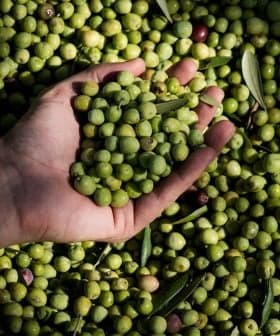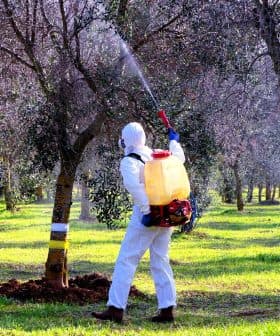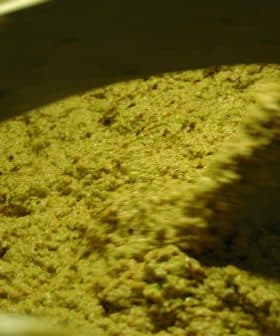Improved DNA Tracing Puts Olive Oil Adulterers on Notice
Spanish scientists are close to offering “paternity tests” for virgin olive oil to combat fraud, using DNA fingerprinting to verify the variety and origin of the oil. The test, which only requires small samples, is expected to be commercially available within six months and would complement other verification tests.
By Julie Butler
Olive Oil Times Contributor | Reporting from Barcelona

Dr. Juan de Dios Alche and Dr. Fendri Mahdi
Spanish scientists claim they are close to offering “paternity tests” for virgin olive oil which would be a powerful ally against fraud.
Their advances in the art of DNA fingerprinting mean they now need only relatively small samples - typically 100 – 200ml - to verify if virgin olive oil is really of the variety and origin claimed.
And unlike chemical and sensory tests - the results of which can at most strongly indicate the oil has been cut with another vegetable oil - finding the DNA of say hazelnut or sunflower oil in olive oil is unequivocal proof of its presence, they say.
Dr. Juan de Dios Alché, lead researcher on the Spanish National Research Council (CSIC) project, told Olive Oil Times there is still much work to do but he hopes within six months the test will be commercially available.
“We’ve already had quite a few contacts from people in the food sector, including in the United States, and believe there is a lot of demand for it,” he said.
Alché, from CSIC’s department of Biochemistry, Cell and Molecular Biology of Plants, part of the Estación Experimental del Zaidín institute in Granada, also explained that it would substantially complement, but not replace, other verification tests.
Olive Oil Times: What are the advantages of this test?
Dr. Juan de Dios Alché: Virgin olive oil is relatively expensive and people are willing to pay more for qualities they value, such as oil from a particular region or variety, something dishonest producers take advantage of. With this test we can verify an olive oil’s authenticity, confirming whether it really is of the origin and variety, or varieties, stated on the label.
Q: What are its limitations?
A: This is not a test that will determine the grade of an olive oil. Also, it requires detection of intact DNA, which is often hard to find in refined oil. That’s one of the reasons it’s designed to be used for virgin olive oil and should be seen as a complement to other tests, not a replacement.
Also, in some cases we are unable to positively analyze samples because they have very, very small amounts of DNA or because the DNA is degraded. In such cases we have to use larger samples, sometimes up to 1 liter. The use of high temperatures during milling is one way in which DNA is degraded.
Q: How did you come to develop the test?
A: As part of our research on pollen we developed a big database of DNA fragments taken from the leaves of more than 90 different olive varieties, mainly from Spain, Portugal and Tunisia, but also with the most common varieties from Italy, Greece, France, Morocco and Lebanon.
One of its uses is to certify the olive variety from olive pollen allergy vaccines but we tried and found we could also use it to identify olive oil, even though in Spain the whole olive fruit, including the seed, is crushed to make oil and we don’t know exactly where the DNA we find in it comes from.
Q: Your database is based on DNA from olive tree leaves yet scientists have reported finding the DNA in leaves from an olive tree didn’t match that of the tree’s oil.
A. We have found that in the vast majority of cases they do coincide.
Q. How does the test work?
A: It’s based on the use of microsatellites (also known as SSRs - Simple Sequence Repeats) as molecular markers. We extract DNA and use what’s known as polymerase chain reaction (PCR) to amplify these SSR sequences. We then check their size by sequencing and comparing sizes with what’s already in our database.
Other molecular markers now appear to provide even higher resolution fingerprinting than SSRs but we still use microsatellites because there are already many databases based on them, such as ours, they are easy to interpret and reproduce, and they have high discriminatory power.
Q: Does the test take long and is the sample pre-treatment complicated?
A: It currently takes 7 – 10 days, including analysis. We extract the DNA using a centrifuge, solvents and commercial kits we have customized, and use specialized laboratory equipment for the test, especially a PCR thermocycler and capillary sequencer. The necessary sample pre-treatment is not that complicated, relatively speaking.
Q: What progress have you made in the last two years?
Apart from expanding the database, we’ve optimized the process of extracting DNA from oil samples. We use various methods to extract the DNA, some of them commercially available ones, but customized by us, and we’ve also optimized the amplification process.
Q. Would this test be cost-efficient enough to be widely used?
A. The price is not determined yet because we’re not making any commercial use of our method. But we have found there is demand for it from the food sector and it’s possible that in about six months we’ll be able to offer it as a service and yes, it would be affordable. A small sample can verify a big batch of oil.
Q: What are you working on now?
The test takes a long time so we’re trying to reduce that. We also plan to test a wider range of olive oil.
Furthermore, while we’ve been able to detect DNA from hazelnut and sunflower oils in olive oil, so far we can only confirm the presence of extraneous oils, we can’t quantify the proportion, so that’s something we’re also working on.
Further reading on molecular markers and verifying olive oil authenticity:
- Olive Oil Traceability, Olive Germplasm — The Olive Cultivation, Table Olive and Olive Oil Industry in Italy, Dr. Innocenzo Muzzalupo (Ed.)
- An Overview of the Authentication of Olive Tree and Oil
- Living in the 70’s – Detecting adulteration by seed oils, Richard Gawel
Sources:
Technique developed to detect potential olive oil fraud. (Press release in Spanish from of the Spain’s National Research Council’s Zaidín Experimental Station.)
Fighting food fraud with science, Chemistry World
Olive Identification Gets Fast and Easy, Olive Oil Times









